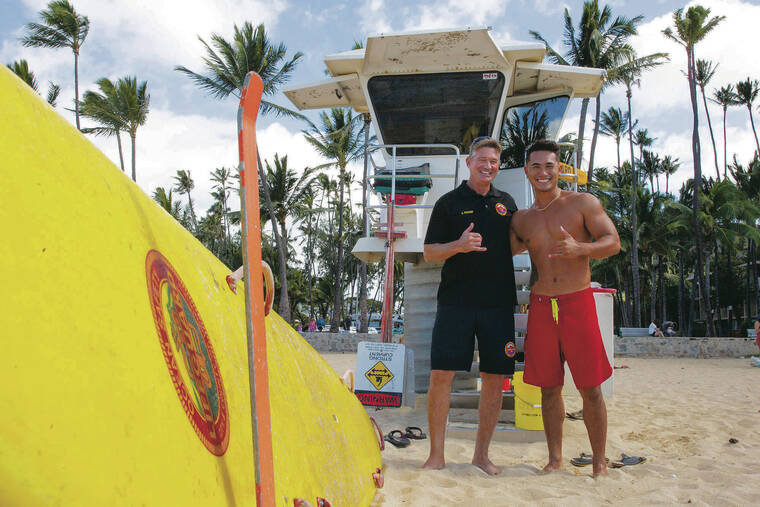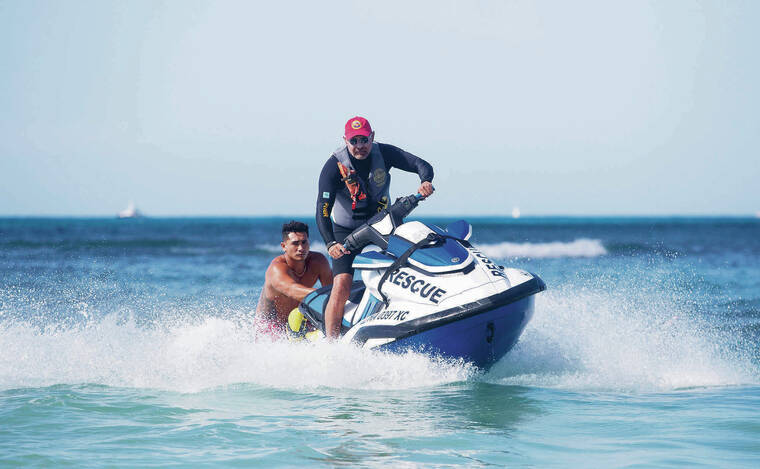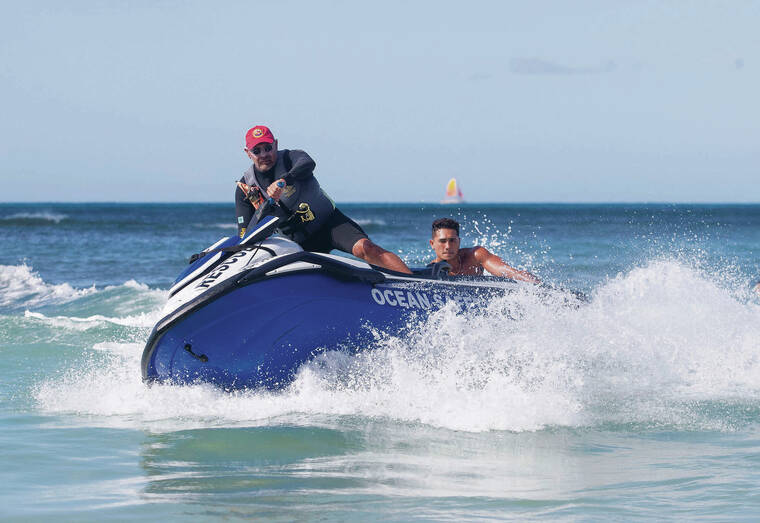Bryan Phillips, a Honolulu Ocean Safety personal watercraft operator on
Oahu’s North Shore, went off duty at 5:30 p.m. Dec. 17. It was the end of the 8-1/2-hour workday most city lifeguards are on duty.
Forty-three minutes later, after sundown,
a call came in for a swimmer in distress at Ke Iki Beach near Banzai Pipeline. The waves there were breaking with 15- to 20-foot faces on a rising swell.
Phillips said he called the sole water safety officer in the area who was working late that day, a lieutenant who said he was driving to the scene, ready to swim out alone to rescue the victim.
“It’s really frightening and a really dangerous situation for a responder to go on a call alone with no rescue Jet Ski unit, no eyes on the beach to back him up,” said Phillips, who told the officer to call “if he was going in, and I’d be there.”
The lieutenant arrived to find the swimmer had made it safely ashore, but the situation, Phillips said in a phone interview, underscored the urgency of extending the hours of all personal watercraft operators in Ocean Safety’s partially implemented “dawn-to-dusk” program. Coverage would extend to 8 a.m.-6:30 p.m. from the current 9 a.m.-5:30 p.m.
“We know that when we are needed most — everywhere — is from 5 p.m. to sunset, (but) we are off to a slow start with this program,” said John Titchen, chief of Ocean Safety, a division of the city’s Emergency Services Department.
Titchen said the program rollout, which had been scheduled to start July 1 with
12-hour days for all the division’s 250 water safety officers, including those staffing its
41 lifeguard towers along Oahu’s 227-mile coastline, remained incomplete due to funding delays and differences in bureaucratic rules between the city and the Hawaii Government Employees Association.
“The city Department of Human Resources and HGEA have to make it happen,” said Phillips, president of HGEA’s lifeguard bargaining unit.
Ocean Safety personnel currently working extended hours are still working a 40-hour week, Titchen said, with an alternate work schedule of four 10-hour days or three
12-hour days.
They comprise the 20 personnel, including tower lifeguards, at Hanauma Bay — 10 in the division’s communications unit, 10 in the training unit — “and our 15 supervisors, the captains and lieutenants, who are mobile (patrolling in all-terrain vehicles and trucks),” he said in a phone interview.
Titchen added that his first priority was, and remains, to extend hours for the division’s eight rescue personal watercraft teams, each of which has two lifeguards.
“If rescue Jet Ski units were on the same schedule, then the lieutenant responding to the call at Ke Iki Beach could have notified
a two-person Jet Ski team to meet him,” said Phillips.
“Statistically, we can show that lifeguards are essential during earlier and later hours in the day,” Titchen said, noting that from July 1 through
Dec. 21, Ocean Safety officers responded to 1,357 calls for assistance, 278 of which arrived between 6-9 a.m. and 5-8 p.m.
“Now we have the evidence to show that we are responding to calls for assistance evenly throughout all hours of daylight,” he said, adding that from the times the 278 calls came in, “we know that we are needed more at the end of the day than earlier.”
The 1,357 calls for assistance, Titchen said, came via 911, other government agencies or calls from Ocean Safety personnel “spotting a major incident that requires a significant response,” he said, such as a sinking vessel; dive, surf or swim accidents; in-ocean disappearances, drownings and near-
drownings; monk seal, whale and shark incidents; and providing CPR or first aid on the beach.
The 278 before- and after-
hours calls, he said, came from all around the island: Kailua, Waikiki, Kahe Point and Makaha, and the North Shore; many of the cases involved surfing, kite surfing, foiling, windsurfing and kayaking.
Not represented in the
278 calls were “the hundreds
of rescues we do daily, such
as charging in at Sandy’s with tube and fins, and the thousands of preventative actions, such as using a megaphone at Waimea Bay to warn visitors back from the high wash of
the waves,” Titchen said.
He added that the
extended-hours alternate work schedule has been seen to improve employee morale and performance by letting them rest and recuperate for an extra day.
Every day, he said, Ocean Safety deploys as many as 24 mobile teams in emergency response trucks and personal watercraft: There are eight two-officer rescue personal watercraft teams — two each on Oahu’s south, north, windward and leeward shores — and his next priority was to add a third team on each of those coasts as “the best and quickest way to achieve an extended-hours program and really begin to spread our coverage universally around the island.”
Achieving this had been
delayed in part due to lack of funding for a summer 2021 recruit class, Titchen said, but the City Council has now provided funding for 2022 “and we are very excited about bringing in
the largest recruit class Ocean Safety has seen in decades.”
Eighty applicants have registered to try out for a potential 25 spots in a spring 2022 class, he said; physical tryouts, involving running and swimming set distances within a time limit, are scheduled for Jan. 7 and 8, and recruits will start off as part-time, contract employees.
Titchen and Phillips warned that as the days grow longer, it will stay progressively lighter in the evenings until past 7 p.m. in summer, and officers’ start and end times should ideally be staggered accordingly.
“We need extended hours now, while we have the opportunity with the shorter days to get it going, and figure out how it can be tweaked” to maximize coverage, Phillips said, noting that summer, with more daylight hours, brought more time for people to get in trouble, such as jumping off rocks at Spitting Caves and elsewhere, regardless of wave size.






